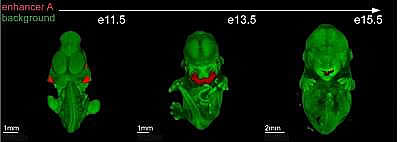|
|
Gene found for cleft palate
Experts feel this discovery will help development of medical approaches to prevent the condition.
A cleft lip is the result of a gap forming in the upper lip. If the gap extends into the roof of the mouth it is called a cleft palate. Clefts are failures in newly forming jaw structures beginning about Carnegie stage 16, and are among the most common birth defects.
Each year, approximately 250,000 babies worldwide are born with a cleft, or about two babies a day in the United Kingdom (UK). An international team, led by Newcastle University, UK, and the University of Bonn in Germany, has now found variants near a gene called GREM1 (Gremlin1) significantly increase risk for both.
The research paper is published in the journal PLoS Genetics.
"The findings reveal a link between GREM1 and specific clinical characteristics that arise in the formation of a cleft lip and palate.
"This is very important in this research area as it helps decipher the complex interplay between genes required for different steps in different tissues during lip and palate development.
"A cleft lip can occur with or without a cleft palate and genetic factors that predispose palate involvement are largely unknown."
Heiko Peters PhD, Reader in Mammalian Genetics, Newcastle University's Institute of Genetic Medicine, and senior author.
Dr. Peters studies embryogenesis, or bringing about and morphogenesis of organs through a series of tissue interactions. This involves modifications of gene expression patterns which coordinate growth, shape and differentiation in a newly forming organ. He uses the developing tooth of the mouse as his primary model system. His laboratory investigates the molecular “cross-talk” that regulates early tissue interactions.
Analysis of genetic and clinical data from three large patient groups, identified a strong relationship between a region on chromosome 15 and the clefting of the human lip and palate. Experiments on mice investigating when and where GREM1 is normally active during facial development, found it is not the loss of GREM1 function but rather its increased activity that causes the cleft palate condition.
This is the second gene shown to be linked to the condition in which a cleft of the lip and a cleft of the secondary palate occur together.
Dr Peters: "These findings provide a framework for further analyses of GREM1 in human cell systems and model organisms, broadening our understanding of the processes that regulate the shape of the face."
Although not life-threatening for patients who can access postnatal surgery, cleft lip and palate requires multidisciplinary care by ear, nose and throat experts, orthodontists and speech therapists. Children with the condition can have dental issues, speech problems and are at increased risk of serious ear infections and hearing loss.
Currently, scientists only have a fragmented picture of which genes are required for lip and palate development. Or, how environmental factors might interact with genetic risk factors. To establish prevention, scientists must identify all genetic risk factors to understand how gene to gene and even gene to environment interactions interfere with lip and palate growth.
As the use of personalised medicine increases, understanding how genetic changes alter fetal development will become increasingly important.
In particular for conditions such as cleft lip and palate — which appear to be caused by a combination of genetic and environmental factors, such as smoking and/or certain medicines used by the mother.
Further studies will focus on identifying genes and environmental factors that interact with GREM1.
Author Summary
Clefts of the lip and palate are common birth defects, and require long-term multidisciplinary management. Their etiology involves genetic factors and environmental influences and/or a combination of both, however, these interactions are poorly defined. Moreover, although clefts of the lip may or may not involve the palate, the determinants predisposing to specific subphenotypes are largely unknown. Here we demonstrate that variations in the non-coding region near the GREM1 gene show a highly significant association with a particular phenotype in which cleft lip and cleft palate co-occur (nsCLP; P = 8.13×10−14). Our data suggest that the risk is even higher for patients who have a cleft lip and a cleft of the soft palate, but not of the hard palate. Interestingly, this subphenotype corresponds to the expression of the mouse Grem1 gene, which is found in the developing lip and soft palate but not in the hard palate. While Grem1-deficient mice display no lip or palate defects, we demonstrate that ectopic Grem1 protein alters palatal shelve morphogenesis. Together, our results identify a region near GREM1 as the second, genome-wide significant risk locus for nsCLP, and suggest that deregulated GREM1 expression during craniofacial development may contribute to this common birth defect.
Authors
Kerstin U. Ludwig, Syeda Tasnim Ahmed, Anne C. Böhmer, Nasim Bahram Sangani, Sheryil Varghese, Johanna Klamt, Hannah Schuenke, Pinar Gültepe, Andrea Hofmann, Michele Rubini, Khalid Ahmed Aldhorae, Regine P. Steegers-Theunissen, Augusto Rojas-Martinez, Rudolf Reiter, Guntram Borck, Michael Knapp, Mitsushiro Nakatomi, Daniel Graf, Elisabeth Mangold, Heiko Peters
Reference
Meta-analysis reveals genome-wide significance at 15q13 for nonsyndromic clefting of both the lip and the palate, and functional analyses implicate GREM1 as a plausible causative gene
Published in PLoS Genetics. DOI: 10.1371/journal.pgen.1005914
Return to top of page
|
|
|
Apr 13, 2016 Fetal Timeline Maternal Timeline News News Archive

RED indicates the margins of the mouse cranial folds coming together to meet as the jaw and mouth.
Image Credit: Science In The Classroom, Science, AAAS
|
|
|
|



